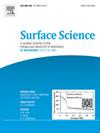The influence of alkali and alkaline earth substitution on the reduction of Fe2O3[001] by H2 – a DFT study
IF 1.8
4区 化学
Q3 CHEMISTRY, PHYSICAL
引用次数: 0
Abstract
The reactivity of Fe2O3 oxygen carriers (OCs) in the presence of alkali and alkaline earth metal substitutions was investigated using density functional theory (DFT) to enhance their reduction behavior. Our calculations reveal that these substitutions preferentially occupy surface sites on Fe2O3[001], rather than the bulk. Compared to alkaline earth metals, the surface oxygen vacancy formation energy (Evac), a measure of reducibility, is substantially lower near alkali substitutions, indicating more oxygen release. Additionally, we investigated H2 oxidation and adsorption on pure and Na-substituted Fe2O3[001] surfaces that have an oxygen vacancy. Adsorption energies demonstrate that H2 preferentially dissociates on O top and hollow sites rather than on Fe-related sites. The oxidation of H2 is both thermodynamically and kinetically more advantageous on O sites, resulting in the production of H2O via either direct adsorption or H atom migration pathways. Conversely, Fe sites demonstrate elevated steric hindrances and reduced reactivity. Finally, oxygen migration from the bulk to the surface was identified as a mechanism driven by high temperatures, which may influence oxygen availability during cycling. These findings offer essential understanding of the impact of substitutions on the redox behavior of Fe2O3 OCs, relevant to applications in chemical looping and sustainable hydrogen consumption.

碱和碱土取代对H2 - a - DFT还原Fe2O3的影响[001]
采用密度泛函理论(DFT)研究了Fe2O3氧载体(OCs)在碱金属和碱土金属取代物存在下的反应性。我们的计算表明,这些取代优先占据Fe2O3的表面位置[001],而不是大块。与碱土金属相比,表面氧空位形成能(Evac),一种还原性的度量,在碱取代附近明显较低,表明更多的氧释放。此外,我们还研究了H2在具有氧空位的纯Fe2O3和na取代Fe2O3[001]表面上的氧化和吸附。吸附能表明H2优先在O顶和空心位点而不是铁相关位点解离。H2在O位上的氧化在热力学和动力学上都更有利,从而通过直接吸附或H原子迁移途径生成H2O。相反,铁位表现出空间位阻升高和反应性降低。最后,氧从体向表面的迁移被确定为高温驱动的机制,这可能影响循环过程中的氧可用性。这些发现对取代对Fe2O3氧化还原行为的影响提供了重要的理解,与化学环和可持续氢消耗的应用有关。
本文章由计算机程序翻译,如有差异,请以英文原文为准。
求助全文
约1分钟内获得全文
求助全文
来源期刊

Surface Science
化学-物理:凝聚态物理
CiteScore
3.30
自引率
5.30%
发文量
137
审稿时长
25 days
期刊介绍:
Surface Science is devoted to elucidating the fundamental aspects of chemistry and physics occurring at a wide range of surfaces and interfaces and to disseminating this knowledge fast. The journal welcomes a broad spectrum of topics, including but not limited to:
• model systems (e.g. in Ultra High Vacuum) under well-controlled reactive conditions
• nanoscale science and engineering, including manipulation of matter at the atomic/molecular scale and assembly phenomena
• reactivity of surfaces as related to various applied areas including heterogeneous catalysis, chemistry at electrified interfaces, and semiconductors functionalization
• phenomena at interfaces relevant to energy storage and conversion, and fuels production and utilization
• surface reactivity for environmental protection and pollution remediation
• interactions at surfaces of soft matter, including polymers and biomaterials.
Both experimental and theoretical work, including modeling, is within the scope of the journal. Work published in Surface Science reaches a wide readership, from chemistry and physics to biology and materials science and engineering, providing an excellent forum for cross-fertilization of ideas and broad dissemination of scientific discoveries.
 求助内容:
求助内容: 应助结果提醒方式:
应助结果提醒方式:


